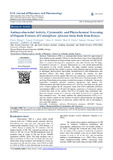| dc.contributor.author | Mwangi, C. | |
| dc.contributor.author | Nimbeshaho, F. | |
| dc.contributor.author | Abdulai, Y. | |
| dc.contributor.author | Chacha, M.R. | |
| dc.contributor.author | Ndirangu, Ephantus G. | |
| dc.contributor.author | Ajaiyeoba, E.O. | |
| dc.contributor.author | Kigondu, E.V.M. | |
| dc.date.accessioned | 2020-07-02T13:05:52Z | |
| dc.date.available | 2020-07-02T13:05:52Z | |
| dc.date.issued | 2020-04 | |
| dc.identifier.citation | EAS Journal of Pharmacy and Pharmacology, Volume-2 Issue-2 Mar-Apr:2020 | en_US |
| dc.identifier.issn | 2663-6719 | |
| dc.identifier.uri | https://www.researchgate.net/publication/342154357_Antimycobacterial_activity_cytotoxicity_and_phytochemical_screening_of_organic_extracts_from_Commiphora_africana | |
| dc.identifier.uri | https://academicjournals.org/journal/JMPR/article-abstract/9EC92A663380 | |
| dc.identifier.uri | http://hdl.handle.net/123456789/4411 | |
| dc.identifier.uri | https://doi.org/10.5897/JMPR2020.6905 | |
| dc.description.abstract | Tuberculosis (TB) is a communicable disease that kills approximately three million people annually. Efforts to treat the disease have been made difficult due to the development of drug-resistant strains and co-infection with HIV/AIDS. There is a need to develop new, inexpensive, safe, and effective anti-TB drugs. Commiphora africana (C. africana, Burseraceae) is a very useful plant and has been known to treat several ailments. The plant contains various secondary metabolites and has been found to possess many pharmacological activities such as antifungal, antimicrobial, antioxidant, hepatoprotective, anti-inflammatory and anti-ulcer effects. The study aimed at screening the extracts for their antimycobacterial activity against Mycobacteria smegmatis; cytotoxicity in Vero cells; qualitative phytochemical analysis and Thin Layer Chromatography (TLC) profiling. Phytochemical screening revealed the presence of alkaloids, flavonoids, terpenoids, coumarins, phenols, saponins, sapogenins, and tannins. The dichloromethane and ethyl acetate extracts of C. africana stem bark were the most active extracts against the M. smegmatis strain used with a minimum inhibitory concentration (MIC99) of 1.30 and 2.60 mg/mL, respectively. Cytotoxicity studies revealed that most of the extracts had CC50>20 µg/mL thus considered safe. However, hexane extract of C. africana stem bark showed CC50 | en_US |
| dc.language.iso | en | en_US |
| dc.publisher | East African Scholars Publisher | en_US |
| dc.subject | Commiphora africana | en_US |
| dc.subject | Mycobacteria smegmatis ATCC607 | en_US |
| dc.subject | Synergy | en_US |
| dc.subject | Additive | en_US |
| dc.subject | Minimum Inhibitory Concentration | en_US |
| dc.subject | and Cytotoxicity | en_US |
| dc.title | Antimycobacterial Activity, Cytotoxicity and Phytochemical Screening of Organic Extracts of Commiphora Africana Stem Bark from Kenya | en_US |
| dc.type | Article | en_US |

